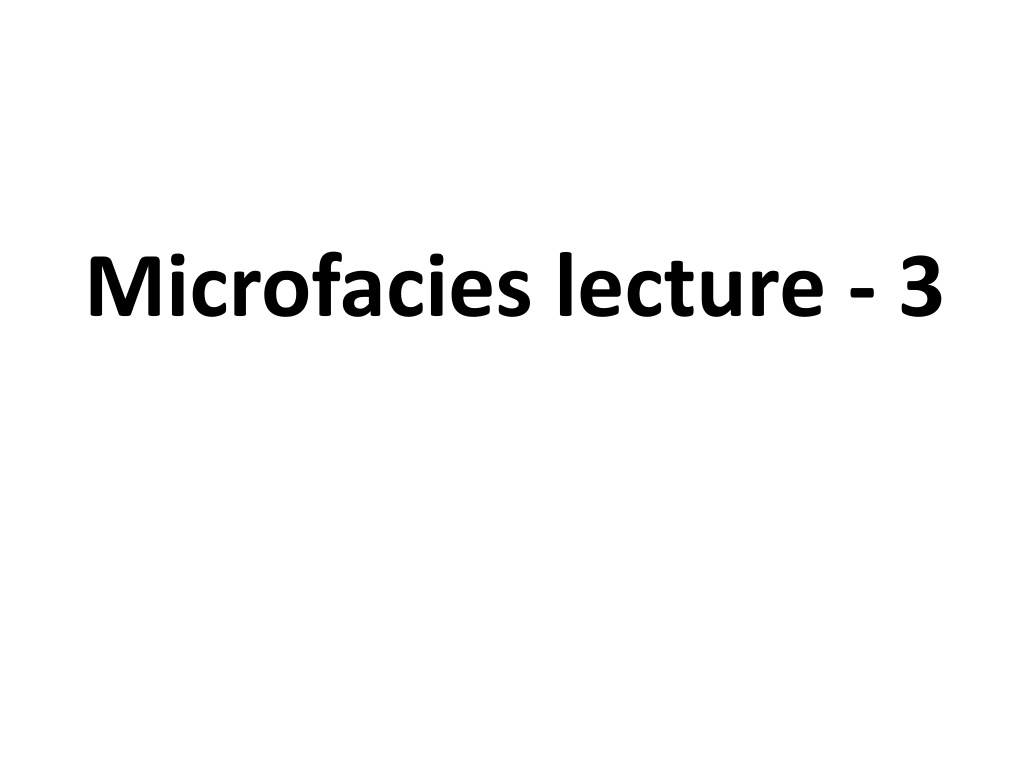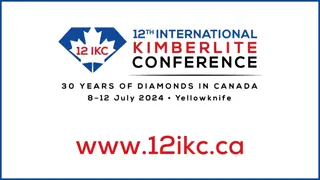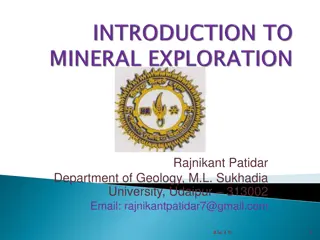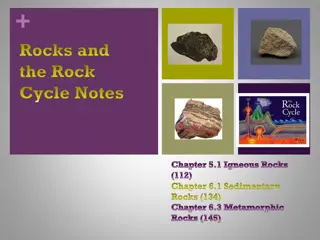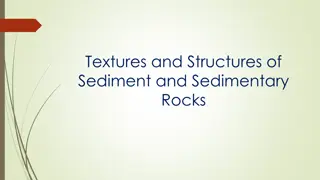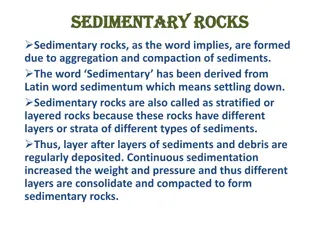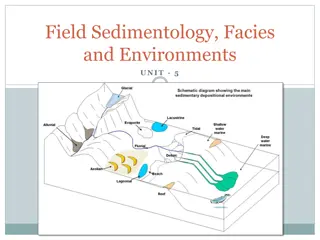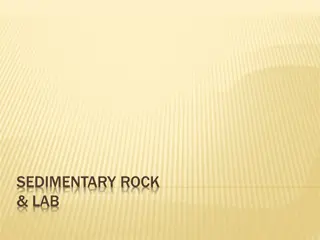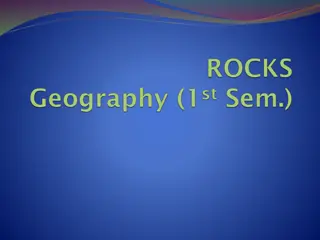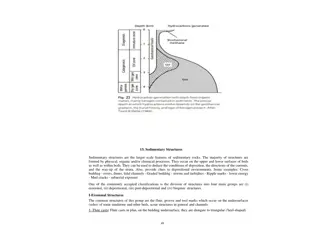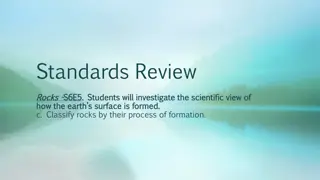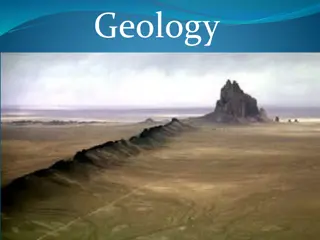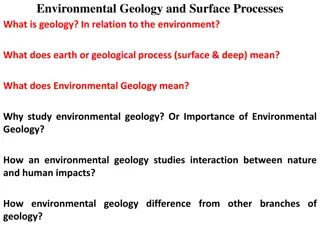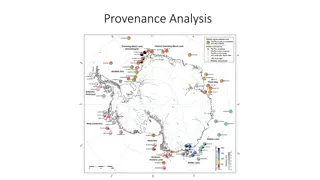Understanding Microfacies Analysis in Sedimentary Geology
This chapter discusses field work studies, sampling strategies, and laboratory methods essential for microfacies analysis. It emphasizes the importance of precise field records, vertical and lateral variations in sampling, and studying microscopic features along with mineralogical and geochemical data. Field observations form the basis for analyzing sedimentary deposits, highlighting criteria such as lithology, texture, color, bedding, structures, diagenesis, fossils, and biogenic structures. Recommended references for field methods and textbooks on litho- and biofacies studies are also provided.
Download Presentation

Please find below an Image/Link to download the presentation.
The content on the website is provided AS IS for your information and personal use only. It may not be sold, licensed, or shared on other websites without obtaining consent from the author. Download presentation by click this link. If you encounter any issues during the download, it is possible that the publisher has removed the file from their server.
E N D
Presentation Transcript
This chapter summarizes field work studies, sampling strategies and laboratoy methods relevant to microfa- cies analysis. A precise field record of geological and paleontological data as well as sampling strategies that consider the vertical and lateral variations in these data are vital for the success of microfacies studies. Labo- ratory methods study microscopic features and miner- alogical and geochemical data.
Many Criteria That Are Important In Facies Interpreta- Tion Can Not Be Recognized Sufficiently In Small-scale Microfacies. Paleoenvironmental Interpretations De- Rived From Microfacies Should Be Controlled By Litho- Logical Criteria And Sedimentary Structures Evaluated By The High Information Potential Provided By Fossils And Biogenic Structures. Microfacies Sampling Requires An Understanding Of The Meaning Of Bedding And The Depositional Charac- Ters Reflected By Sedimentary Structures.
Field Work Forms The Basis For Studying Sedimentary Deposits. Criteria That Can Be Studied In Outcrops And Cores In Facies Analyses Are: Lithology, Texture, Rock Color, Bedding, Sedimentary Structures And Diagenetic Features, And Fossils And Biogenic Structures.
A Highly Recommended Description Of Field Meth- Ods Is Given By Tucker (1982). The Methods Used In The Study Of Litho- And Biofacies Of Sedimentary Rocks Are The Subject Of Several Textbooks (Leeder 1982; Lewis 1984; Pettijohn Et Al. 1987; Miall 1990; Chamley 1990; Blatt 1992, Friedman Et Al. 1992, Lewis And Mcconchie 1993; Boggs 1995; Reading 1996; Leeder 1999; Miali 2000; Einsele 2000)
Lithology: Sedimentary Rocks Are Classified Into Silici- Clastic Rocks (Claystone/Mudstone, Siltstone And Sand- Stone), Conglomerates And Breccias, Carbonate Rocks (Limestone, Dolomite), Mixed Siliciclastic- carbonates (Marl, Argillaceous And Sandy Limestones), Evaporites (Gypsum, Anhydrite, Salt), Siliceous Sedimentary Rocks (Cherts), Phosphorites And Organic-rich Rocks.
Carbonate rocks make up 20 to 25 percent of all sedimentary rocks in the geological record and are clas- sified into limestones and dolomites (dolostones); see Fig. 3.1. Limestones consist of more than 50% CaC03. They comprise limestones and dolomitic limestones. Dolomites are composed of more than 50% CaMg(C03), and are subdivided into calcitic dolomites (50-90% do- lomite) and dolomites.
Although detailed differentia- tion of carbonate rocks is best performed in the labora- tory, field distinctions can also be made, using dilute 10% hydrochloric acid (limestone will fizz strongly, dolomite will show little or no reaction).
Bedding and Stratification, Sedimen- tary Structures and Diagenetic Features
Many of the structures described in this subchapter can also be recognized at a microfacies scale, particularly sedimentary fabrics and diagenetic textures (Fig. 3.4). Bedding and stratzfication: Carbonate rocks are strati- fied or non-stratified. Non-strat@cation is a result of (a) primary lack of bedding (e.g. in reefs), (b) bed-de- structing processes (e.g. intensive burrowing), or (c) diagenetic processes (e.g. dolomitization or strong recrystallization of limestones).
Headline Of Microfacies Course 1- preface 2-
Field Work and Sampling . . . . . . . . . . . . . . . . . . . . . . . . . . . . . . . . . . . . . . . Field Observations . . . . . . . . . . . . . . . . . . . . . . . . . . . . . . . . . . . . . . . . . . . . Lithology. Texture and Rock Colors . . . . . . . . . . . . . . . . . . . . . . . . . . . . . . Bedding and Stratification. Sedimentary Structures and DiageneticFeatures ........................................... Fossils and Biogenic Structures . . . . . . . . . . . . . . . . . . . . . . . . . . . . . . . . . . Field Logs and Compositional Logs . . . . . . . . . . . . . . . . . . . . . . . . . . . . . . Sampling . . . . . . . . . . . . . . . . . . . . . . . . . . . . . . . . . . . . . . . . . . . . . . . . . . . . Search Sampling and Statistical Sampling . . . . . . . . . . . . . . . . . . . . . . . . . . How Many Samples? .......................................... Practical Advice for Microfacies Sampling ......................... Laboratory Work: Techniques . . . . . . . . . . . . . . . . . . . . . . . . . . . . . . . . . . . Slices. Peels and Thin Sections . . . . . . . . . . . . . . . . . . . . . . . . . . . . . . . . . . Casts. Etching and Staining . . . . . . . . . . . . . . . . . . . . . . . . . . . . . . . . . . . . . Microscopy . . . . . . . . . . . . . . . . . . . . . . . . . . . . . . . . . . . . . . . . . . . . . . . . . . Petrographic Microscopy ....................................... StereoscanMicroscopy ........................................ Fluorescence. Cathodoluminescence and Fluid Inclusion Microscopy .... Mineralogy and Geochemistry ................................... Trace Elements and Stable Isotope Analysis ........................
